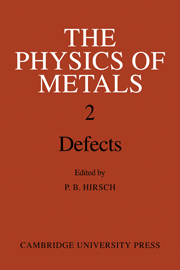6 - Fracture
Published online by Cambridge University Press: 04 August 2010
Summary
ATOMIC FORCES AND THE STRENGTH OF SOLIDS
Professor Sir Nevill Mott was one of the first to realise, at the beginning of the 1930s, that, with the arrival of quantum mechanics, the road at last lay open for the creation of a general theory of bulk matter in terms of atomic and electronic structure and properties. The great programme of solid state physics was thus begun.
In parts of this programme, for example in the theory of metallic conductivity, a quantum theory of solids could be developed directly by finding suitable, if approximate, solutions of Schrodinger's equation. In others, however, the physical situation proved too complex for this approach. The strength and plastic properties of solids, for example, are not determined by the average behaviour of the atoms but by the exceptional behaviour of those relatively few atoms situated at lattice irregularities. The theories of such properties could not be developed without providing some intermediate concepts, to by-pass the mathematically formidable and to some extent physically irrelevant problem of solving Schrodinger's equation for lattice irregularities, and to enable the theory to work directly in terms of the atoms and their movements. One of the most useful of these has been the representation of the cohesion of a solid in terms of ‘atomic bonds’, i.e. force–displacement relations between pairs of atoms such as that in fig. 6.1.
For covalent solids this representation can be justified quantummechanically, but for metals it is highly artificial and must be used with care.
- Type
- Chapter
- Information
- The Physics of Metals , pp. 247 - 280Publisher: Cambridge University PressPrint publication year: 1976
- 4
- Cited by



